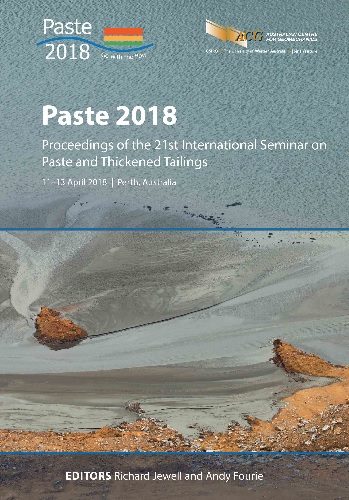Dewatering options for management of fine gold tailings in Western Australian Goldfields

|
Authors: Moreno, JJ; Kendall, S; Ortiz, A |
DOI https://doi.org/10.36487/ACG_rep/1805_34_Moreno
Cite As:
Moreno, JJ, Kendall, S & Ortiz, A 2018, 'Dewatering options for management of fine gold tailings in Western Australian Goldfields', in RJ Jewell & AB Fourie (eds), Paste 2018: Proceedings of the 21st International Seminar on Paste and Thickened Tailings, Australian Centre for Geomechanics, Perth, pp. 413-424, https://doi.org/10.36487/ACG_rep/1805_34_Moreno
Abstract:
Typical tailings disposal systems in the Western Australian Goldfields consist of tailings paddock facilities, where tailings are discharged either from a single outlet or from spigots around a ring dyke. Upstream raising and central decanting of supernatant water is common practice. Potential evaporation in this region is high, at around 2 m per year, with summer months accounting for more than half of the evaporation. This presents a challenge in maintaining a steady rate of water recovery from the facility’s pond throughout the year, especially if large shallow ponds are formed. This generates a variable fresh water demand that may not be easy to satisfy if availability of a constant source is limited. Dewatering tailings prior to disposal may prove a good alternative since, if correctly designed, a reasonably steady flow with consistent reduced water content can be expected from the thickeners or filters. Nonetheless, there is a perception that dewatering could add significant capital expenditure and complexity to the project. The current development of both thickening and filtration technologies, along with the increased number of technology providers, has reduced the capital and operating cost significantly over the last few years. This, combined with the benefit of improving water recovery, can make thickening and filtration options viable for gold processing plants handling relatively low throughputs. As a case study, an evaluation of alternative tailings water recovery systems for a gold mine project in the Goldfields region was undertaken. The objective was to determine the optimal tailings water management strategy for the project. The most important aspects evaluated were capital costs and water supply. This paper presents the conclusions of the evaluation and incorporates additional aspects such as landform development, closure and environmental impacts.
Keywords: dewatering, filtration, high-density gold tailings
References:
Fourie, AB 2012, ‘Perceived and realised benefits of paste and thickened tailings for surface deposition’, in RJ Jewell, AB Fourie and A Paterson (eds), Proceedings of the 15th International Seminar on Paste and Thickened Tailings, Australian Centre for Geomechanics, Perth, pp. 53–64.
Vick, SG 1983, Planning, Design and Analysis of Tailings Dams, John Wiley & Sons, Hoboken.
© Copyright 2025, Australian Centre for Geomechanics (ACG), The University of Western Australia. All rights reserved.
View copyright/legal information
Please direct any queries or error reports to repository-acg@uwa.edu.au
View copyright/legal information
Please direct any queries or error reports to repository-acg@uwa.edu.au



